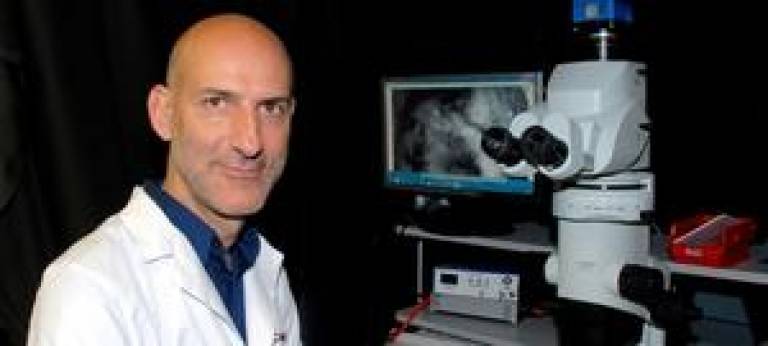Spotlight on Prof Matteo Carandini
30 October 2015

Professor Matteo Carandini is the GlaxoSmithKline Professor of Visual Neuroscience at the UCL Institute of Ophthalmology. His research is aimed at understanding how neuronal cells in a region of the brain called the visual cortex integrate and process sensory information received by the eyes, and integrate it with information from the rest of the brain.
Find out a little bit more about Matteo's work in his own words:
Q: Can you tell us a little bit about your research and what you hope to achieve in the long term?
I am trying to understand the activity of single neurons and populations of neurons in a region of the brain called the visual cortex. This activity depends not only on visual stimuli, but also on what the rest of the brain is doing. In the lab, we record brain activity of mice while they navigate a virtual environment, and we seek to summarize this activity using simple computational models. The long-term goal is a cohesive understanding of how the brain processes visual information. This goal probably won’t be achieved in my lifetime for the human brain, but for the mouse brain it might.
Q: Were there key moments in your research life that led you to where you are today?
Twenty years ago I went to a summer course at Cold Spring Harbor, which was run by David Heeger (then of Stanford University) among others. I became fascinated by his ideas on the simple arithmetic governing the responses of neurons in visual cortex. He became a long-distance mentor and then a collaborator. His ideas and his example have shaped my career. Another fundamental encounter was with Massimo Scanziani (now at University of California, San Francisco). Both are great examples of how to tackle scientific questions and of how to move into new areas of research.
Q: Why did you choose to study the visual system over other areas of the brain?
Visual cortex is an ideal workbench to study the cerebral cortex: we know how to get lots of spikes from it (thanks to Hubel and Wiesel), we can stimulate it with precision and ease (thanks to the video cards present in all computers), and we can easily image it (it lies largely on the surface of the brain). For this reason, progress in understanding visual cortex has been substantial, allowing scientists to produce simple yet very powerful models of the underlying computations.
Q: How has working at UCL benefited your research?
UCL is a wonderful collaborative environment. For example, consider a key technique that we now use in my lab, a virtual reality environment for mice. The central elements of this environment were developed by the Hausser lab here at UCL, and by sharing these with the rest of the UCL neuroscience community they have given UCL a real competitive advantage. Also, we were delighted when we could help Rachael Pearson and Robin Ali in their seminal study involving the implant of stem cells in the eye: their laboratories pursue these fascinating and promising treatments of eye disease, and we were delighted to be able to help their study by imaging the brain of mice that had received the treatment.
Links:
Some of Matteo's recent publications:
Okun, Steinmetz, …, Mrsic-Flogel, Carandini, and Harris, "Diverse coupling of neurons to populations in sensory cortex", Nature. (2015)
Sato, Häusser, and Carandini, "Distal connectivity mediates summation and division across mouse visual cortex", Nature Neuroscience. (2014)
Haider, Häusser, and Carandini, "Inhibition dominates sensory responses in the awake cortex", Nature. (2013)
error message: 'NoneType' object has no attribute 'to_html'
error message: 'NoneType' object has no attribute 'to_html'
 Close
Close

